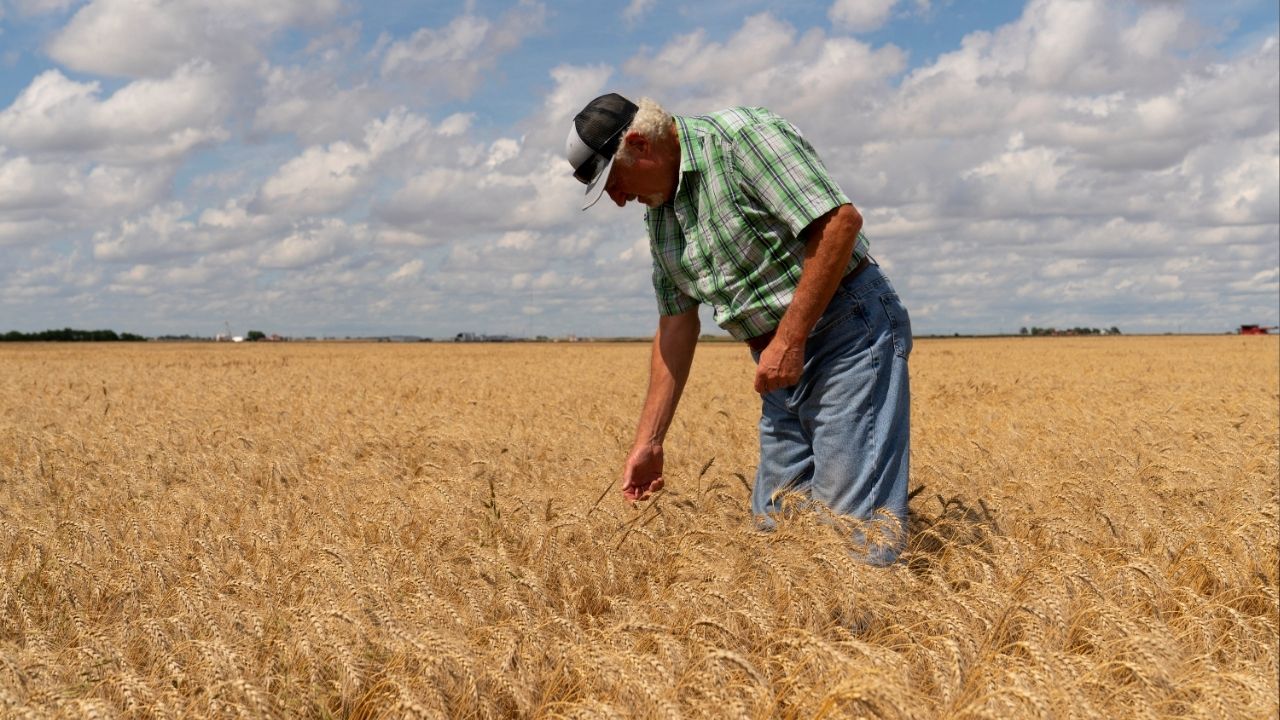Dennis Schoenhals inspects wheat at his farm in Kremlin, Oklahoma, U.S., June 12, 2025. (Reuters/Nick Oxford)

- U.S. wheat farmers are abandoning fields amid five-year price lows, choosing hay or cattle over harvesting unprofitable grain crops.
- Drought, low global prices and more profitable alternatives like corn and soybeans are forcing Plains farmers to pivot from wheat.
- Once a symbol of heritage, hard red winter wheat is declining across the Midwest as modern agriculture favors higher-yield crops.
Share
|
Getting your Trinity Audio player ready...
|
COLBY, Kansas – On a foggy morning in May, Dennis Schoenhals drove a carload of crop scouts around the wheat fields of northern Oklahoma, part of an annual tour to evaluate the health of the crop. But on some fields, Schoenhals and other farmers had already abandoned plans to harvest the grain for sale because prices had sunk to five-year lows.
Farmers cut their losses early this year across the U.S. wheat belt, stretching from Texas to Montana. They were choosing to bale the wheat into hay, plow their fields under or turn them over to animals to graze. In Nebraska, wheat acreage is less than half of what it was in 2005.
For farmers with crop insurance, damaged or unprofitable wheat fields can still earn revenue. But many agree that chasing insurance payouts is not the best business model.
The Great Plains have long been celebrated for the “amber waves of grain” in the popular hymn “America the Beautiful.” The region’s states produce most of the U.S.-grown crop of hard red winter wheat, favored by bakers for bread. But with prices hovering around $5 per bushel, U.S. wheat farmers have reached an inflection point, with many forced to either lose money, feed wheat to cattle or kill off the crop.
Interviews with more than a dozen farmers and analysts across Kansas, Nebraska and Oklahoma, along with a review of U.S. Department of Agriculture data, revealed a vast disparity in profit for wheat compared to other crops. This has led farmers to abandon more fields before harvest.
In parts of the region, prolonged drought has lowered yields in recent years. Farm revenue has also suffered in years with healthy rainfall, as abundant global supplies have weighed on prices. Many have pivoted to corn, soy or livestock, often after generations of their family growing wheat exclusively.
“They can’t sustain that,” said Schoenhals, 68, who raises crops and cattle near Kremlin, Oklahoma, and is president of the state’s wheat growers association. “Eventually you either change to other crops if you’re able to, or you go out of business,” he said.
Two years ago, severe drought drove farmers to abandon about a third of the U.S. crop. This year, healthy green stalks shot through the cracked soil, and farmers had expected to harvest the most bushels per acre since 2016. But wheat prices hit a five-year low in May.
Every year since 2020, farmers have abandoned between a fifth and a third of the winter wheat crop, U.S. Department of Agriculture data show.
Nationwide, corn and soybeans dominate crop fields, with wheat a distant third in planted acreage.
Hard red winter wheat exports hit historic lows in 2024 after drought and lower prices in other wheat-producing areas of the world squeezed the U.S. commodity’s competitiveness.
In Kansas, the leading U.S. producer of hard winter wheat, the disparity between acreage and value is particularly stark. About 1.3 million more farm acres in Kansas were planted with wheat than with corn in 2024, USDA data show, but corn’s value of production was more than twice as high.
Plentiful global supplies have kept benchmark U.S. prices stuck at lows that discourage farmers from growing wheat, producers and analysts told Reuters. Supplies are so ample that droughts in important grain-growing regions of China and Russia this year have barely budged prices.
“We’re below profitable levels for these guys,” said Darin Fessler, an analyst with Lakefront Futures in Lincoln, Nebraska, who grew up on a row crop farm in nearby Sutton.
The way things stand, he said, many farmers have “eaten a lot of their own money and burned up working capital. These bankers are going to say: ‘show me some profits or we’re going to have some farm sales.'”
Heritage But No Profit
Ties to wheat farming run deep in the Plains. Historically, European settlers in Kansas struggled to find a foothold until Mennonites from Ukraine arrived with seeds of Turkey Red wheat, a variety that proved able to withstand the area’s dry soil, harsh winters and extreme temperature swings.
The seeds spread to neighboring Oklahoma and Nebraska, where pioneers established homesteads in the sandy, light earth in which wheat thrived but other crops struggled. Hard red winter wheat has remained the main variety of wheat sown in the U.S.
Images of golden stalks adorn hotel lobbies and road signs, and towns include the word in their names. Pulitzer Prize-winning author Willa Cather, a daughter of Red Cloud, Nebraska, wrote a celebrated poem describing “the miles of fresh-plowed soil, heavy and black, full of strength and harshness.”
Now, U.S. wheat growing is on a steady decline, with farmers finding surer profits from corn, soybeans or cattle. On the wheat quality tour in May, weeks before Nebraska wheat is usually harvested, no wheat could be seen for miles around Red Cloud.
When Royce Schaneman joined Nebraska’s wheat board 19 years ago, wheat fields stretched for 2.2 million acres across the state. Since then, acreage has shrunk to less than a million acres, he said. In Cheyenne County in southern Nebraska, the state’s most productive wheat-growing land, about one in five fields was abandoned this year.
“The feeling out in the country is not good,” he said.
Generations of farmers grew wheat because the crop thrived on rainfall alone. In recent decades, farmers have invested in pricey irrigation systems, experimented with hardier varieties and used fertilizer to improve yields.
Agronomists have helped farmers grow more bushels per acre even as climate change has brought more drought and pests. Producers in the southern Plains have experimented with other types of wheat such as durum, the kind used for pasta, and a gluten-free variety, pursuing customers willing to pay more.
Profits remain elusive.
“It’s heritage, but there’s no profit,” said Lon Frahm, the CEO of Frahm Farmland, a 40,000-acre operation in Colby, Kansas. Surrounding Thomas County is now dotted with wind farms. Farmers there once grew wheat exclusively, he said, but they have started to diversify due to more frequent drought and global competition depressing prices.
Frahm himself now mainly plants corn. He irrigates, fertilizes and harvests the grain using multimillion-dollar machines, then stores it in gleaming, 80-foot steel grain bins. His 7,000 acres of wheat sometimes produce just 5 percent of his farm’s total output.
“There’s certainly profit in corn,” he said.
—
(By Emily Schmall; Editing by Simon Webb and David Gregorio)
RELATED TOPICS:
Categories

Fresno Train-Vehicle Collision Causes Traffic Disruptions

US Dollar Tumbles After Fed Cuts Rates, Powell Comments

















